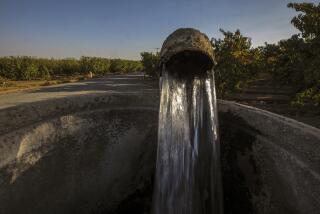‘89 Drought Chances Slim, Experts Say
- Share via
The chances are only 1 in 10 that California’s water shortage will extend into a third consecutive dry year, state experts said Friday at a symposium on the prospects for further drought.
The projection was made by the state Department of Water Resources as part of its “Drought Contingency Planning Guidelines for 1989.” A preliminary draft of the plan was shown to Southern California water agencies Friday in Los Angeles.
The symposium was sponsored by the Southern California Water Committee--formed by local governments and water agencies--and the Department of Water Resources to solicit comment on the contingency planning proposal.
The state has just come through back-to-back dry years that have hit some areas of Northern and Central California hard, but left Southern California relatively unscathed, state officials said.
Water Shortages Reported
In the 12 months ended Oct. 1, 45 of the state’s 58 counties reported water shortages, adversely affecting 45% of irrigated agriculture and 26% of the population, the experts said. By mid-September, 14 counties and two cities had declared drought emergencies. Fish and wildlife resources and recreation also have suffered, according to the experts.
While Southern California has had normal or above-normal rainfall, the run-off from these storms was far below normal because much of the moisture was absorbed by the parched lands. Shorter supplies caused the city of Los Angeles to put into effect the first phase of its water conservation ordinance, curtailing some uses of water.
Orange County Supervisor Harriett M. Wieder, chairwoman of the Southern California Water Committee and moderator of the symposium, said rain, snow and river flows in key watersheds are at least 50% below normal, while small communities with limited reservoir storage or shallow ground water basins are experiencing shortages.
Tighter Water Management
“We can handle a third dry year,” said Carl Boronkay, general manager of the Metropolitan Water District of Southern California, which provides water to 27 member agencies that serve 14.5 million consumers south of the Tehachapi Mountains.
If it comes, however, Boronkay said Southland cities and water agencies would have to intensify their water management, undertake a major public education program and regulate water use in the urban areas.
Statewide, reservoir storage was 14.8 million acre-feet on Oct. 1, about two-thirds of normal, officials said. An acre-foot is enough water to serve two urban families for a year, or irrigate one-third acre of cotton.
While the probabilities of a third critically dry year are are very slim, according to David N. Kennedy, director of the state Department of Water Resources, he told the symposium “We are here to think about the unthinkable. . . . We hope the worst doesn’t happen.”
Not since the year 1597 has the state gone through three drought years in a row, said Bob Singado, who helped draft the contingency plan. By studying growth rings in trees and other biological evidence, scientists have traced historical weather patterns and used them to predict that the chances for a three-year repeat are only 1 in 10, he said.
If a third dry year does occur, plans call for water conservation, the transfer of water from areas of surplus to areas of shortage and for more pumping from underground supplies. The half-inch thick planning document addresses specific needs of each area of the state.
Donald Heath, manager of the Water Resources Department’s Drought Center, said the preliminary draft of the plan was presented to all water agencies in the state this week for review. The water agencies and the public have until Nov. 7 to file their comments and suggestions with the drought center, he said. The final plan is to be completed by year’s end.
David R. Schuster, general manager of the State Water Contractors, which manages the California Aqueduct, said a repeat of 1976-77 drought conditions could mean agriculture users would lose 100% of their normal state water project entitlements and cities would have one-half reductions in their shares of state aqueduct water.
More to Read
Sign up for Essential California
The most important California stories and recommendations in your inbox every morning.
You may occasionally receive promotional content from the Los Angeles Times.













